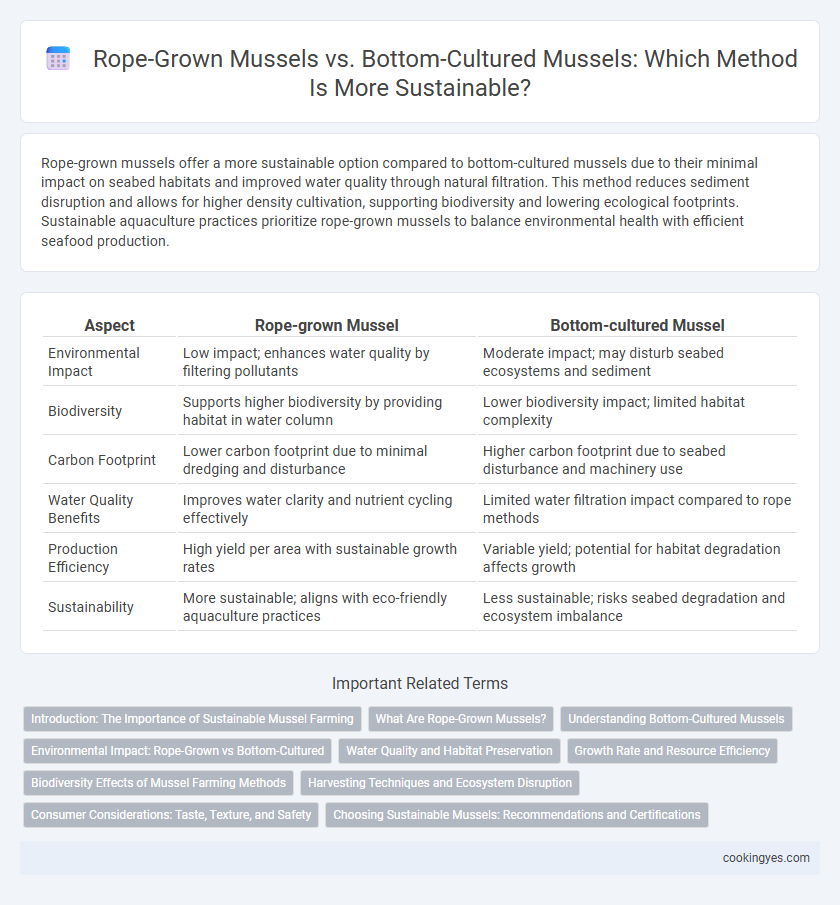Rope-grown mussels offer a more sustainable option compared to bottom-cultured mussels due to their minimal impact on seabed habitats and improved water quality through natural filtration. This method reduces sediment disruption and allows for higher density cultivation, supporting biodiversity and lowering ecological footprints. Sustainable aquaculture practices prioritize rope-grown mussels to balance environmental health with efficient seafood production.
Table of Comparison
| Aspect | Rope-grown Mussel | Bottom-cultured Mussel |
|---|---|---|
| Environmental Impact | Low impact; enhances water quality by filtering pollutants | Moderate impact; may disturb seabed ecosystems and sediment |
| Biodiversity | Supports higher biodiversity by providing habitat in water column | Lower biodiversity impact; limited habitat complexity |
| Carbon Footprint | Lower carbon footprint due to minimal dredging and disturbance | Higher carbon footprint due to seabed disturbance and machinery use |
| Water Quality Benefits | Improves water clarity and nutrient cycling effectively | Limited water filtration impact compared to rope methods |
| Production Efficiency | High yield per area with sustainable growth rates | Variable yield; potential for habitat degradation affects growth |
| Sustainability | More sustainable; aligns with eco-friendly aquaculture practices | Less sustainable; risks seabed degradation and ecosystem imbalance |
Introduction: The Importance of Sustainable Mussel Farming
Rope-grown mussels offer a sustainable aquaculture method by minimizing seabed disturbance and promoting water filtration, which enhances marine ecosystems. Bottom-cultured mussels may impact benthic habitats through sediment disruption but support natural nutrient cycling in coastal environments. Sustainable mussel farming balances ecological health with efficient production, making rope-grown techniques increasingly favored for environmental conservation.
What Are Rope-Grown Mussels?
Rope-grown mussels are cultivated by suspending ropes vertically in nutrient-rich coastal waters, allowing mussels to filter feed naturally and benefit from cleaner environments with less sediment disturbance. This method enhances water quality and reduces habitat damage compared to bottom-cultured mussels, which grow directly on seabeds and can disrupt benthic ecosystems. Rope-grown mussels typically have lower environmental impacts, supporting sustainable aquaculture by promoting biodiversity and minimizing pollutant accumulation.
Understanding Bottom-Cultured Mussels
Bottom-cultured mussels are grown directly on the seabed, which allows them to filter nutrients efficiently and contribute to benthic ecosystem health while minimizing habitat disruption. Unlike rope-grown mussels suspended in the water column, bottom-cultured mussels often require less maintenance and have a lower risk of waste accumulation, making them a sustainable aquaculture practice. Studies show bottom-cultured methods promote biodiversity and water quality, supporting long-term environmental balance in mussel farming areas.
Environmental Impact: Rope-Grown vs Bottom-Cultured
Rope-grown mussels exhibit a lower environmental impact compared to bottom-cultured mussels due to reduced seabed disturbance and enhanced water flow, promoting healthier marine ecosystems. The suspended ropes minimize habitat destruction and sediment disruption, preserving biodiversity and improving water quality. In contrast, bottom-cultured mussels can alter benthic habitats and increase sedimentation, leading to potential ecological imbalance.
Water Quality and Habitat Preservation
Rope-grown mussels improve water quality by filtering nutrients and contaminants from the water column, reducing eutrophication risks in marine ecosystems. This aquaculture method minimizes seabed disturbance, preserving benthic habitats and supporting marine biodiversity better than bottom-cultured mussels. Sustainable mussel farming practices prioritize rope-grown techniques to protect underwater habitats while maintaining high filtration efficiency and ecosystem balance.
Growth Rate and Resource Efficiency
Rope-grown mussels exhibit faster growth rates due to optimal water flow and nutrient access, enhancing overall yield efficiency. Bottom-cultured mussels often suffer from sedimentation issues that slow growth, leading to prolonged harvest cycles. Resource efficiency is higher in rope-grown systems as they minimize habitat disruption and maximize space utilization, contributing to more sustainable aquaculture practices.
Biodiversity Effects of Mussel Farming Methods
Rope-grown mussels enhance biodiversity by providing vertical habitat structures that support diverse marine species, including fish and invertebrates, compared to bottom-cultured mussels which may disrupt benthic ecosystems through sediment compaction and reduced species richness. Rope cultivation minimizes seafloor disturbance, preserving natural habitats and promoting ecological balance, whereas bottom-cultured methods can lead to habitat degradation and altered community compositions. Sustainable mussel farming favors rope-grown techniques for their positive effects on marine biodiversity and ecosystem resilience.
Harvesting Techniques and Ecosystem Disruption
Rope-grown mussels utilize suspended aquaculture methods that minimize seabed disturbance by allowing mussels to grow off the seafloor, significantly reducing habitat disruption and sediment resuspension compared to bottom-cultured mussels. Bottom-cultured mussels, cultivated directly on the seafloor, often involve mechanical harvesting techniques that can degrade benthic habitats and alter local biodiversity through physical disturbance of sediment and resident organisms. The sustainable advantages of rope-grown mussels include lower environmental impact and enhanced preservation of marine ecosystems, contributing to more resilient coastal biodiversity.
Consumer Considerations: Taste, Texture, and Safety
Rope-grown mussels offer a cleaner, brinier flavor with a firmer texture due to elevated growth conditions, appealing to consumers seeking freshness and taste consistency. Bottom-cultured mussels may exhibit earthier flavors and softer textures from sediment exposure, which some consumers find desirable but others may avoid due to potential grit. Both methods maintain high safety standards, yet rope-grown mussels often have lower contamination risks from sedimentborne pollutants, enhancing their appeal for health-conscious buyers.
Choosing Sustainable Mussels: Recommendations and Certifications
Rope-grown mussels offer a more sustainable option compared to bottom-cultured mussels due to their higher water filtration capacity and less seabed disturbance. Look for certifications such as the Marine Stewardship Council (MSC) and Aquaculture Stewardship Council (ASC) that verify environmentally responsible farming practices. Choosing certified rope-grown mussels supports ecosystem health and promotes sustainable seafood consumption.
Rope-grown Mussel vs Bottom-cultured Mussel for sustainability Infographic

 cookingyes.com
cookingyes.com